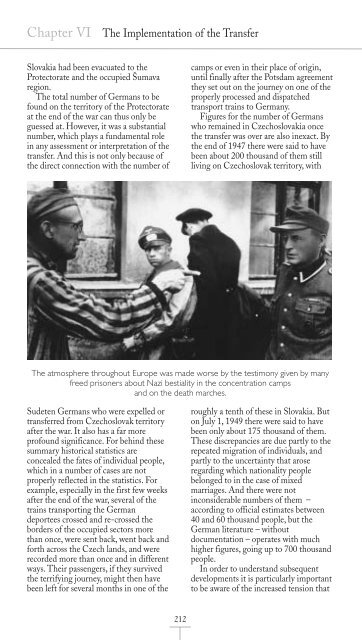the nationality of all inhabitants of the czech provinces and ...
the nationality of all inhabitants of the czech provinces and ...
the nationality of all inhabitants of the czech provinces and ...
Create successful ePaper yourself
Turn your PDF publications into a flip-book with our unique Google optimized e-Paper software.
Chapter VI The Implementation <strong>of</strong> <strong>the</strong> Transfer<br />
Slovakia had been evacuated to <strong>the</strong><br />
Protectorate <strong>and</strong> <strong>the</strong> occupied Šumava<br />
region.<br />
The total number <strong>of</strong> Germans to be<br />
found on <strong>the</strong> territory <strong>of</strong> <strong>the</strong> Protectorate<br />
at <strong>the</strong> end <strong>of</strong> <strong>the</strong> war can thus only be<br />
guessed at. However, it was a substantial<br />
number, which plays a fundamental role<br />
in any assessment or interpretation <strong>of</strong> <strong>the</strong><br />
transfer. And this is not only because <strong>of</strong><br />
<strong>the</strong> direct connection with <strong>the</strong> number <strong>of</strong><br />
Sudeten Germans who were expelled or<br />
transferred from Czechoslovak territory<br />
after <strong>the</strong> war. It also has a far more<br />
pr<strong>of</strong>ound significance. For behind <strong>the</strong>se<br />
summary historical statistics are<br />
concealed <strong>the</strong> fates <strong>of</strong> individual people,<br />
which in a number <strong>of</strong> cases are not<br />
properly reflected in <strong>the</strong> statistics. For<br />
example, especi<strong>all</strong>y in <strong>the</strong> first few weeks<br />
after <strong>the</strong> end <strong>of</strong> <strong>the</strong> war, several <strong>of</strong> <strong>the</strong><br />
trains transporting <strong>the</strong> German<br />
deportees crossed <strong>and</strong> re-crossed <strong>the</strong><br />
borders <strong>of</strong> <strong>the</strong> occupied sectors more<br />
than once, were sent back, went back <strong>and</strong><br />
forth across <strong>the</strong> Czech l<strong>and</strong>s, <strong>and</strong> were<br />
recorded more than once <strong>and</strong> in different<br />
ways. Their passengers, if <strong>the</strong>y survived<br />
<strong>the</strong> terrifying journey, might <strong>the</strong>n have<br />
been left for several months in one <strong>of</strong> <strong>the</strong><br />
212<br />
camps or even in <strong>the</strong>ir place <strong>of</strong> origin,<br />
until fin<strong>all</strong>y after <strong>the</strong> Potsdam agreement<br />
<strong>the</strong>y set out on <strong>the</strong> journey on one <strong>of</strong> <strong>the</strong><br />
properly processed <strong>and</strong> dispatched<br />
transport trains to Germany.<br />
Figures for <strong>the</strong> number <strong>of</strong> Germans<br />
who remained in Czechoslovakia once<br />
<strong>the</strong> transfer was over are also inexact. By<br />
<strong>the</strong> end <strong>of</strong> 1947 <strong>the</strong>re were said to have<br />
been about 200 thous<strong>and</strong> <strong>of</strong> <strong>the</strong>m still<br />
living on Czechoslovak territory, with<br />
The atmosphere throughout Europe was made worse by <strong>the</strong> testimony given by many<br />
freed prisoners about Nazi bestiality in <strong>the</strong> concentration camps<br />
<strong>and</strong> on <strong>the</strong> death marches.<br />
roughly a tenth <strong>of</strong> <strong>the</strong>se in Slovakia. But<br />
on July 1, 1949 <strong>the</strong>re were said to have<br />
been only about 175 thous<strong>and</strong> <strong>of</strong> <strong>the</strong>m.<br />
These discrepancies are due partly to <strong>the</strong><br />
repeated migration <strong>of</strong> individuals, <strong>and</strong><br />
partly to <strong>the</strong> uncertainty that arose<br />
regarding which <strong>nationality</strong> people<br />
belonged to in <strong>the</strong> case <strong>of</strong> mixed<br />
marriages. And <strong>the</strong>re were not<br />
inconsiderable numbers <strong>of</strong> <strong>the</strong>m –<br />
according to <strong>of</strong>ficial estimates between<br />
40 <strong>and</strong> 60 thous<strong>and</strong> people, but <strong>the</strong><br />
German literature – without<br />
documentation – operates with much<br />
higher figures, going up to 700 thous<strong>and</strong><br />
people.<br />
In order to underst<strong>and</strong> subsequent<br />
developments it is particularly important<br />
to be aware <strong>of</strong> <strong>the</strong> increased tension that


